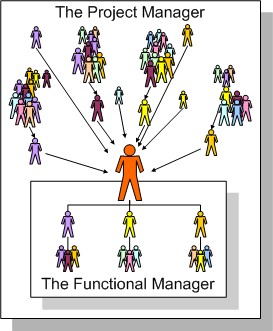It’s Project Leadership, Not Management

Written by Todd C. Williams
1 It’s Project Leadership, Not Management
We have all heard it before… “Project management is easy. We have been managing people for hundreds of years. Just take any manager, give them a project, and tell them to get it done.” Experienced project managers will quickly predict how this story will end—there is an overwhelming chance this project will fail. Leaders deliver project value on time and within budget, they do not “manage.” To distinguish the project manager further from functional managers—the latter only needs to manage subordinates, while successful project managers lead extended project teams. This fundamental difference drastically increases the responsibility of the project manager, since the extended project team includes an entire herd of stakeholders.
1.1 The Project Managers Purview
Functional managers are primarily responsible for their direct reports—the classical organization chart (see the figure to the right). On regular occasions, they coordinate with their peers or a boss, but their focus is on their staff. Project managers, on the other hand, have a much larger array of people to keep aligned. Besides their project team and peers, they have an entire organization chart above them consisting of the project’s stakeholders. In actuality, this loosely knit collection could be a significantly larger population than their well-organized subordinate project team.
Close to my home outside Portland, Oregon, there has been a twenty-year long effort to build a new bridge across the Columbia River. The two, currently steel, structures, one constructed in 1917 and the other in 1958, were built long before seismic design and construction techniques entered into the mainstream and are the weakest link in the only interstate highway that connects Washington, Oregon, and California. There is a legitimate concern about their ability to sustain a reasonably sized trembler. Without a doubt, it will be a massive undertaking building a new multimodal, dual-decked, mile-long bridge. It will take thousands of designers, managers, and construction workers. However, consider the stakeholders involved. They include: the federal transportation agencies, the US military (a reserve airbase is nearby), the Coast Guard, two state and two city governments, two transit agencies, light-rail proponents and opponents, bicyclists, pedestrians, local toll-paying citizenry, state tax payers (many hundreds of miles away wondering why they need to pay anything), boaters, businesses, truckers, commuters, environmentalists, and Native Americans, just to name a few. All have special interests; all can muck up the best project plan. Few of them know anything about project management; none of them care about the woes of the project manager. Without a doubt, stakeholders have and will continue to deliver more pain than almost any project team could while actually building the bridge.
1.2 Training Superiors and Stakeholders
Your projects may be much smaller, but they still need project managers that can lead without authority and train leaders and stakeholders who are ignorant of their project management deficiencies. Never expect executives and sponsors to know what project managers need to properly execute their jobs. It is paramount that project managers use these people as tools to get projects completed, which means training them on how to do their jobs. Project managers must unapologetically assign them tasks just like everyone else on the project. They work for the project manager. The sooner the project manager convinces everyone of this, the better the project will run.
To underscore the point, think back on the last few sponsors you saw assigned to projects. Did they want to be in that role? Had they done the job before? Did they ask for reports on progress or did they request assignments to help the project? Too often, projects inherit project sponsors as an afterthought—likely assigned under duress. The project manager has the responsibility to help delineate what is required of them to make the project successful. This includes clarifying and constraining the project’s scope, acquiring subject matter experts, and finding the extra money when it is obvious that the project is bigger than anyone thought, among many other tasks.
The executives? They should be mentoring project managers, helping with costs, and cutting through the politics. If they are not doing this, the project manager must teach them to do so. Most likely, the project team members understand their project roles; I doubt the leaders and stakeholders do.
1.3 Delegating Up
Of course, a project managers’ job is to run the project; however, if they are confounded by a problem, it is better to ask for guidance than to flail and fail.
A few years ago, I was called in to fix a project that was going to be 200% over budget and schedule. Yes, 200%. That means three times the cost and three times as long. Sad but true. The product would benefit two departments; however, only one was funding it. The investigation showed that nearly all of problems were “above” the project in the management hierarchy. The leadership was dysfunctional. A Vice President for the non-funding department requested that one of the project’s team members blind-copy her on all emails and communications regarding scope. The VP would then use this information to have her team bias the requirements in her department’s favor. Upon discovering this, I bundled up the evidence and trudged into her boss’ office—an executive three layers above me in the organization and second-in-command for the multi-billion dollar company. I made my case in a logical and dispassionate manner asking him to stop the covert action. By the time I returned to my desk (three blocks from the executive’s office), the reverberations had hit the project team, with a memo reprimanding the use of the blind copy feature. He took care of the situation as I left his office. He wanted to help, he was unaware of the problem, and when he became aware of the issue, helped me regain command and control over my project by removing the meddling manager. Less than a month later, I had to invoke the assistance of another executive, this time the VP of Information Technology, asking him to stop the drone of negativism from one manager regarding the now recovered project’s team. The offender apologized for hindering our progress. Executives want to help; we simply need us to tell them what to do.
1.4 Success is Contagious
Stepping up and being a leader, helps you, your peers, and the entire organization. Leadership begets success and success is contagious. Peers mimic victories. Your actions will change the company’s culture and the change sticks because everyone benefits. Change that helps does not meet the same apathetic demise of other change efforts. It only takes that you focus on three directives that lead your leaders:
- I need you to help me by...
- I need mentoring on ...
- I need clarification on...
About the Author:
Todd C. Williams is the founder and president of eCameron, Inc. (www.ecaminc.com), they help companies make their vision profitable. He has over 25 years of experience in recovering failing projects, preventing their failure, and applying those lessons to help other organizations fulfill their strategic goals. He helps his clients through strategic planning facilitation, setting up and running operations, IT leadership, and as an expert witness. He is the author of Rescue the Problem Project: A Complete Guide to Identifying, Preventing, and Recovering from Project Failure. Feel free to connect with him on LinkedIn (linkedin.com/in/backfromred/), Twitter (twitter.com/backfromred), Facebook (facebook.com/BackFromRed), by phone: +1 (360) 834-7361, or email: This email address is being protected from spambots. You need JavaScript enabled to view it..
- Last updated on .


